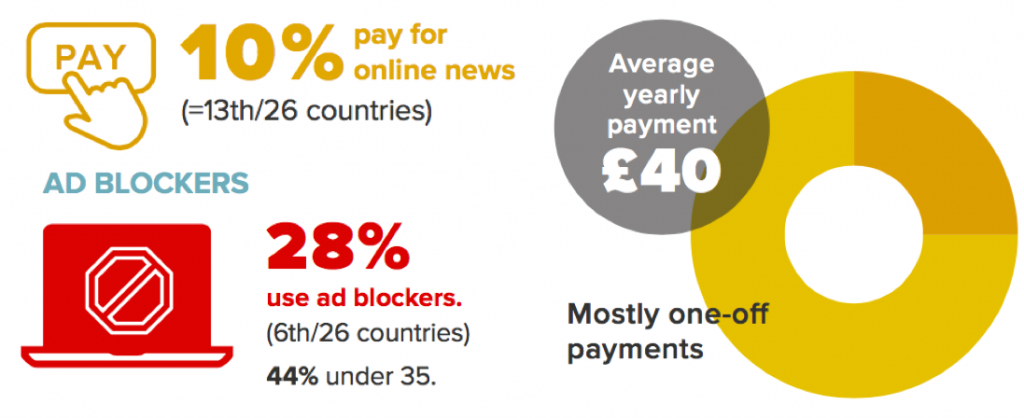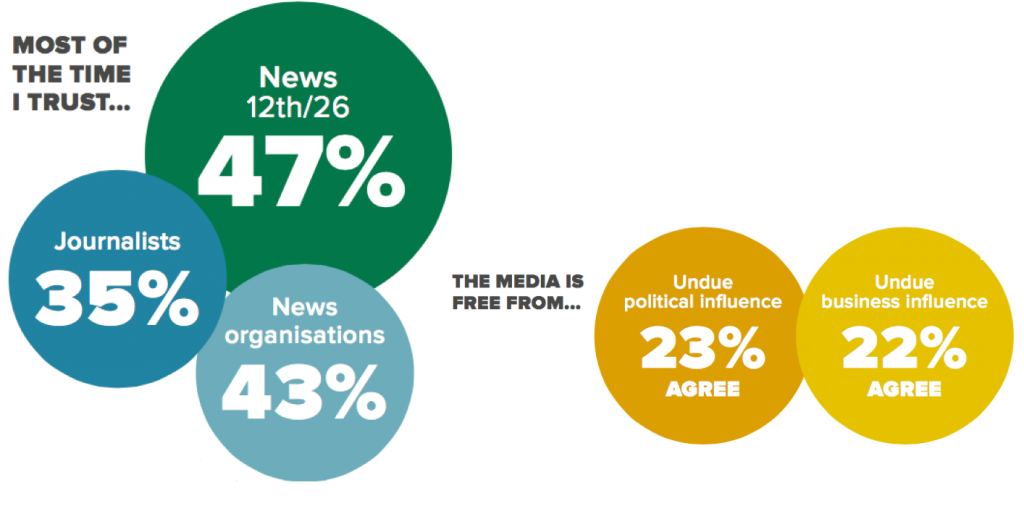| Statistics | |
| Population | 46m |
| Internet penetration | 77% |
Two private operators dominate broadcasting, while newspapers increasingly find audiences online, where they face strong competition from a mix of new and long-running digital natives.
Top Brands % Weekly Usage (TV, Radio and Print)
| Weekly use | Main source | |
|---|---|---|
| Antena 3 news | 55% | 18% |
| LaSexta news | 46% | 15% |
| TVE news | 42% | 12% |
| Telecinco news | 36% | 9% |
| Cuatro news | 35% | 4% |
| El País | 27% | 4% |
| El Mundo | 21% | 2% |
| Cadena SER news | 20% | 4% |
| Regional or local TV news | 19% | 4% |
| 20 Minutos | 17% | 2% |
| Regional or local paper | 14% | 2% |
| Marca | 14% | 1% |
| COPE news | 14% | 3% |
| RNE news | 12% | 2% |
| Onda Cero news | 12% | 2% |
| ABC | 11% | 1% |
Top Brands % Weekly Usage (Online)
| Weekly use | Main source | |
|---|---|---|
| El País online | 34% | 11% |
| El Mundo online | 28% | 6% |
| Antena 3 news online | 23% | 5% |
| 20 Minutos online | 21% | 5% |
| El Confidencial | 20% | 4% |
| Marca online | 18% | 4% |
| El Diario | 17% | 2% |
| Yahoo News | 17% | 4% |
| MSN News | 16% | 5% |
| LaSexta news online | 16% | 2% |
| RTVE news online | 16% | 3% |
| ABC online | 15% | 3% |
| Huffington Post | 14% | 2% |
| Local/Regional paper website | 13% | 3% |
| Público | 13% | 2% |
| El Periódico online | 13% | 3% |
Overview of key developments
By Samuel Negredo, Alfonso Vara and Avelino Amoedo
Center for Internet Studies and Digital Life, University of Navarra
The decline of paid print newspapers accelerated in 2015 as their circulation decreased by 9% – just half of the sales level in 2004 – according to Spanish audit bureau OJD. This affected newsstand sales (-10%) more than subscriptions (-4%). There was a small decrease in broadcast listenership and viewership, while the internet gained almost 2.5 million daily users, up to 26.5 million, according to the EGM study by AIMC. [29. https://www.aimc.es/egm/datos-egm-resumen-general/ Newspaper sites were the most visited.
El País is Spain’s number one print and online brand. Editor-in-chief Antonio Caño recently said that it will become ‘an essentially digital newspaper’, with more video and more coverage from the Americas, but that they will ‘continue publishing a print edition that is of the highest quality for as long as is possible’. [30. https://english.elpais.com/elpais/2016/03/04/inenglish/1457078700_070078.html David Jiménez took over as editor-in-chief of second-place El Mundo – which launched the Sunday supplement Papel – and Juan Ignacio Gallardo was given the same role at leading sports paper Marca. The print business still provided 80% of newspaper revenues in 2015.
Heraldo de Aragón bought 20 minutos from Schibsted, thus acquiring the third most-read newspaper website, and the only remaining major freesheet, with half of its print distribution concentrated in Madrid and the rest in six other cities. Two women were appointed editors-in-chief of the two most-read Catalan-language news sites: Karma Peiró at NacióDigital and Esther Vera at Ara.
The digital native sector saw ElEspañol.com raise €3.6 million from over 5,000 investors, in the most successful journalism crowdfunding campaign ever. The site launched in October 2015. Former La Vanguardia editor-in-chief José Antich founded the bilingual site ElNacional.cat. Other newcomers include okdiario.com,ctxt.es, bez.es, sabemosdigital.com, and revista5w.com. This part of the market is still clearly led by ElConfidencial.com, with Eldiario.es, Público.es, and El Huffington Post also doing well in terms of reach. Vozpópuli, founded in 2011, made a profit (€152,551) for the first time in 2015, joining other digital natives already in the black such as El Confidencia and eldiario.es. These digital native successes may be driven by the ongoing loss of human capital at all levels of many traditional newsrooms and the users’ desire for a broader spectrum of views and news. Private groups Mediaset and Atresmedia dominate the television sector. Between them they reach 60% of the audience, 86% of advertising revenues, with net profits of €162m and €99m in 2015.
The president of market regulator CNMC called this a ‘disturbing duopoly’. [31. https://www.infolibre.es/noticias/medios/2016/02/25/mediaset_atresmedia_logran_multiplicar_sus_beneficios_este_ano_con_respecto_los_2014_45500_1027.html Atresmedia owns the two most popular broadcast news brands: Antena 3 and La Sexta. Most PSBs, in particular state-owned TVE and its news operation, increasingly struggled to reach some sectors of the audience, especially younger groups.
Advertising revenues grew by 8% in 2015, according to Infoadex. The increase was driven by television (+7%), the internet (+12%) and radio (+8%), whereas print managed to remain flat after several years of falling revenue. Our survey shows that 28% of users, including 44% of adults under 35, use ad-blockers. Some sites, including El Confidencial, already ask for them to be switched off before their content can be accessed.
Google Search continues to be a gateway for news even though the News service is not available in Spain, following a 2014 law that forces publishers to charge aggregators for displaying snippets of stories. Major sites are publishing via Facebook Instant Articles and have gone on experimenting with WhatsApp, Telegram, Instagram, Periscope, and Snapchat for coverage, interaction, and distribution, as well as producing highlights graphics and short videos specifically for social media. Digital publishers have adapted to mobile and social consumption with responsive design websites and the launch of viral-friendly sections that play with the curiosity gap.
Changes in media usage 2013–2016
Smartphones have been enthusiastically embraced in Spain with further significant growth over the last year. Majority use is for cheaper Android devices rather than Apple iPhones.
WEEKLY REACH PER DEVICE
| Computer | Smartphone | Tablet | |
|---|---|---|---|
| 2013 | 58% | 36% | 14% |
| 2014 | 68% | 44% | 21% |
| 2015 | 66% | 48% | 24% |
| 2016 | 65% | 58% | 25% |
SOURCE OF NEWS 2013–16
| TV | Online (inc. social) | Social | ||
|---|---|---|---|---|
| 2013 | 72% | 52% | 79% | 28% |
| 2014 | 77% | 51% | 83% | 39% |
| 2015 | 82% | 50% | 86% | 50% |
| 2016 | 79% | 56% | 86% | 60% |
Paying for news
Digital newsstands sell electronic versions of newspapers but otherwise most online news is supported by advertising with few publishers operating paywalls.
Trust
Over half (53%) of users in Spain don’t think that the media are independent from undue political influence, with government control of PSBs an ongoing issue. Over half (51%) are also concerned about financial dependence on big advertisers, owners, and creditors. Ideological bias, partiality, and loaded language are key drivers of mistrust according to our focus group participants.
Scroll data area to see more
TOP SOCIAL NETWORKS*
| RANK | NETWORK | ALL | U35s |
|---|---|---|---|
| 1 | 49% | 59% | |
| 2 | YouTube | 19% | 27% |
| 3 | 26% | 28% | |
| 4 | 19% | 19% | |
| 5 | Google+ | 6% | 3% |


